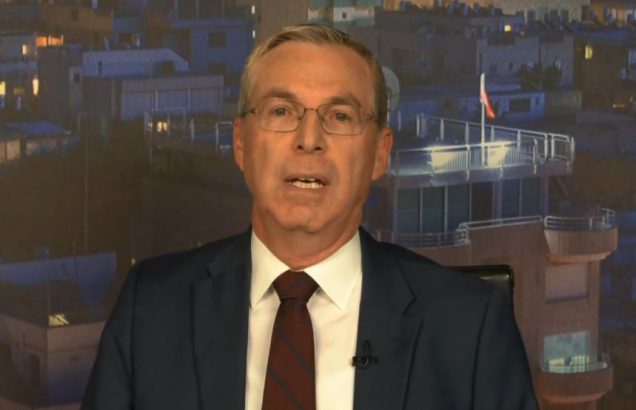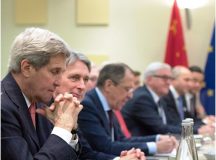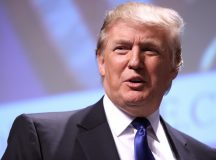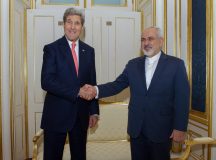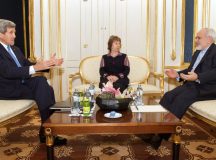Since the US withdrew from the JCPOA nuclear agreement in May, the other signatories have embarked on intensive negotiations in order to try and save the deal from collapsing. At the same time, there are protests in Iran in response to the rising prices of goods and the plummeting value of the Iranian Rial. In this piece, Michael Herzog discusses the strategies of several international actors, the likely response from Iran if the nuclear agreement ultimately collapses and the tough decisions that lie ahead for Israel and the US if Iran moves towards becoming a nuclear threshold state.
There are two major challenges when looking at Iran: the nuclear programme and Iran’s regional activities. These two dimensions are interconnected. Whilst the Joint Comprehensive Plan of Action (JCPOA) nuclear agreement covered only the nuclear programme, the legitimacy and funding it provided Iran have emboldened Tehran to carry out more malign activities in the region in a bid to position itself as the dominant actor in the heart of the Middle East – in Mesopotamia and the Levant – on the ruins of the Arab Spring and ISIS. And while the build-up of Iran’s non-conventional military capabilities and its expanding zone of influence from Iran to the Mediterranean were designed, inter alia, to provide a shield to the nuclear programme, the nuclear programme was designed to ultimately provide an umbrella for Iran’s hegemonic ambitions and power projection in the region.
A new chapter for the JCPOA
The US decision to exit the JCPOA ushers us into a new chapter. However, it will take time for this chapter to unfold before we can sense its precise direction and full impact. Right now, none of the involved parties, first and foremost Iran, is inclined to rush to extreme action in response to the US decision.
The US explained its decision to exit the JCPOA based on four major flaws it identified in the deal: That Iran was essentially given an opening to develop its intercontinental ballistic missile programme, which could serve for future delivery of nuclear weapons (the JCPOA was silent on this issue and the relevant UN Security Council resolution merely ‘called on Iran’ not to do so); the lack of IAEA inspections in undeclared sites, especially military sites (though there is a cumbersome mechanism for that in the JCPOA, Iran resisted it and the IAEA has refrained from challenging Iran); the sunset clauses, which lift most limitations placed on Iran’s nuclear programme after 10 to 15 years, thereby allowing it to become a legitimate nuclear threshold state standing at a critical break out point[1]; and finally, that the deal did not include Iran’s destabilising regional activities.
It appears (though not explicitly expressed this way) that the US goal in exiting the nuclear deal is to either force Iran to negotiate a new deal or bring about regime change. The Trump administration felt it was well positioned to address the aforementioned basic flaws and advance its goals through exiting the deal, rather than fixing it, due to the combination of the powerful tool of US secondary sanctions (i.e., consequences for any third party dealing with Iran) and Iran’s major vulnerabilities manifested in significant domestic unrest and economic/currency problems (see below). Consequently, the Trump administration set 12 demands to Iran – quite fundamental and hard for Iran to comply with and totally rejected by it – and left the door open to negotiations.
Before exiting the deal the US did however carry a dialogue with the other major European to see if they could agree to fixes to the above flaws. They made some progress (especially on the issues of missiles and inspections), but could not reach full agreement especially on how to fix the sunset clauses.
The US decision put a lot of pressure on the major European partners. On the one hand, they objected to its decision and resented the fact that the Trump administration would not give more time and flexibility to their dialogue on fixing the deal. On the other hand, Iran responded to the US move by saying it will remain in the deal and respect its commitments under it only if the Europeans remain in it (alongside Russia and China), fully comply with its terms and compensate Iran for the losses incurred by US sanctions. Europe was put between a rock and a hard place, fearing both the consequences of US sanctions and resumed Iranian nuclear activities.
As a result, the EU announced it will remain part of the deal and the European Commission started a process of adding the renewed US sanctions on Iran to its Blocking Regulation in order to shield European companies doing business in Iran. At the same time, the Europeans pleaded with Iran to remain in the deal and avoid resumed enrichment. However, it is clear that Europe cannot stand against US secondary sanctions. Forced to make a choice between the Iranian and the US markets, European companies’ choice is clear. After all, the volume of European trade with Iran is measured in tens of billions of dollars whereas Europe’s trade with the US surpasses $600bn. French Minister of Finance Bruno Le Maire assessed on 13 June that most French companies will not be able to continue doing business with Iran.
The Russians and the Chinese obviously objected to the US decision to leave the nuclear deal. As far as they’re concerned, they are part of the deal and will continue to work with Iran. In some cases, Russian or Chinese companies stand to benefit from the withdrawal of European companies from Iran by filling the void (e.g., China’s CPNC could absorb Total’s share in the development of the huge off-shore South Pars gas field), and Russia could benefit from the rise of oil prices. That being said, Russia and China cannot compensate for the loss of European investment and technological knowhow, and some of their companies also stand to lose due to US secondary sanctions. We already see some Russian companies (e.g., Lukoil) withdrawing from deals with Iran. The bottom line is that Russia and China are unable to save the deal.
The effect of US sanctions
Indeed, US sanctions (about to kick in and gradually intensify until November) are already registering a major impact. Every week we hear of another giant international company – European and non-European – withdrawing from Iran (especially in the field of energy), such as French Total, UK-based BP, Austrian OMV, Russian Lukoil, Indian Reliance, French carmaker PSA Peugeot Citroen (accounting for about 30 per cent of the Iranian car market) as well as major Japanese and South Korean companies with contracts to build oil tankers, containers and refineries. Iran’s oil exports sharply fell in the first half of June and foreign banks are beginning to pull out. The train is moving fast and this creates a real impact.
Iran and the major EU partners have started a dialogue concerning this issue, but Iran does not appear hopeful. Iran’s Supreme Leader Khamenei stated that Iran does not believe the Europeans will be able stand up to the Americans, and that in any event Iran doesn’t trust the Europeans. Indeed, Tehran is preparing for an outcome in which the EU cannot comply with the terms of the deal. Iran has already announced that it is taking preparatory measures for uranium enrichment in its two major enrichment facilities, Fordo and Natanz, including preparing advanced types of centrifuges. At this phase, Iran is not rushing but rather choosing a low threshold of measures still within the framework of the JCPOA, designed to put it in a position to break out of the agreement and resume hastened enrichment beyond the JCPOA’s scope. In time, assuming the Europeans cannot comply with Iranian demands, one should expect that Iran will resume enrichment and possibly other nuclear activities which were prohibited under the JCPOA.
As noted, Iran is vulnerable economically and socially. In recent months, we have seen the free-fall of the Iranian currency and repeated manifestations of unrest across Iran, mainly on socio-economic ground, including numerous strikes and demonstrations. More recently, hundreds of thousands of truck drivers in Iran went on strike and many protested against the currency falls, to the point of closing Tehran’s bazaar. Iranians are also becoming more vocal in their opposition to the Islamic Republic spending billions of dollars in Syria, Lebanon and Gaza in support of Bashar al-Assad, Hezbollah and Hamas, instead of investing them in Iran. This has become a popular theme of criticism. In two airports in Iran hackers recently took control of screens showing information about flights and posted this criticism. In recent days’ protests in Tehran facing the Parliament demonstrators chanted ‘Death to Palestine’ (read: to hell with Palestine).
It will take time for the impact of US sanctions to be fully felt inside Iran. For now, public response on social media puts the blame for the current situation on either the US and/or the regime’s failures. Public opinion could turn in any of these directions. The JCPOA was controversial in Iran; some hardliners rejected the deal in the first place and many citizens say they haven’t seen or felt the benefits of the deal after two years. Beyond a certain line, US pressure could push Iranian citizens to align behind the regime. At the same time, domestic unrest is likely to deepen and could hit the regime hard.
As noted, one expression of the unrest is the criticism on the regime for investing in Syria, Lebanon and Gaza, which is gaining momentum. For the regime this is an ideological necessity that in their mind protects Iran from external schemes and Khamenei very recently said that those who criticise the regime on this issue serve the enemy. But with time, as things get worse inside Iran, it will become more difficult for the regime to defend these investments, especially if more details of how much they spend come out in public. The Iranian regime funds Hezbollah with at least $700m every year, according to US and Israeli estimates. It also provides Hamas and other armed groups in Gaza somewhere between $70-100m per year and it has given the Assad regime a credit line worth billions of dollars. Since the Arab Spring broke out it is estimated that Iran has invested around $15bn in the region. People are also asking questions about coffins of Iranian soldiers returning from Syria. This is definitely a weak point for the regime.
Even if Iranians put most of the blame on their regime, regime change is no more than speculation at this point. For such a thing to happen, one has to identify organised groups, anti-regime leaders etc. Right now one cannot identify an organised opposition movement in Iran that could topple the regime. Nevertheless, the accumulating pressure from inside and outside Iran could enhance a long-term trajectory in which the regime ultimately departs the scene. How long this will take and how the regime falls no one can really tell.
What next?
Looking ahead, it is unlikely that Iran will sit idly by and do nothing in response to the US and the new reality of sanctions. Nor is it likely to negotiate a new deal in the foreseeable future. The JCPOA was and is a matter of national interest, and a proud Iran is very unlikely to reopen the deal. The more likely scenario is that Iran will resume its nuclear activities with regards to enrichment, albeit slowly and gradually, at each phase sensing the international and domestic response and deciding on how to proceed. There is a range of activities they can take, starting with the lower, less-risky part of the spectrum, and then possibly escalating. The more extreme measures of withdrawing from the Non-Proliferation Treaty, stopping cooperation with the IAEA, kicking out inspectors and going underground with its nuclear programme are less likely in the foreseeable future because they enhance the risk of a US or Israeli military response and they will bring about loss of European support. More likely is that Iran decides to enrich uranium up to 20 per cent using new types of centrifuges and continues to work with the IAEA on its own terms – allowing limited inspections of declared sites. As major sanctions are kicking in, the Iranians don’t have much to lose economically, but this course of action may make it harder to decide on military action against them.
Once Iran resumes its nuclear programme outside the scope of the JCPOA, both the US and Israel will have to redefine their red lines concerning the Iranian nuclear programme, namely where to draw a line, the crossing of which might trigger a military response against Iran. When the JCPOA was agreed a few years ago, Iran was technically about two months away from possibly acquiring sufficient fissile material for one nuclear device. If Iran reaches a critical breakout point, a military response is a possibility. Introducing much more advanced Iranian centrifuges would significantly enhance Iran’s enrichment capacity and shorten the time needed to reach that critical breakdown point.
Since the implementation of the JCPOA, Israel’s defence establishment has been working under the assumption that despite the major faults of the deal it bought Israel time, as it set back the Iranian programme at least by a decade. That timeframe is probably going to be shortened – the cascade of tit for tat will now start ticking and may get to the pre-JCPOA situation sooner than expected. The dilemma of whether to use military means in order to stop Iran from approaching the threshold might face Jerusalem once again, as it did several years ago prior to the JCPOA.
In this context, one also has to carefully follow the unfolding diplomatic process between the US and North Korea. Everyone, including the Iranians, are watching very closely and the situation in the Middle East will be impacted by what develops in the Korean peninsula. If there is a real agreement on the denuclearisation of North Korea, including credible inspections inside the country, then this will strengthen the US’s hand vis-à-vis Iran. If, on the other hand, a weak deal with North Korea emerges that leaves their infrastructure and capabilities in place, this may strengthen the Iranians vis-à-vis the international community. The US administration is well aware of this and hopefully will not lower the standard in its dealing with North Korea.
[1] The break out point is defined in terms of the technical time required to acquire one bomb’s worth of military grade uranium. On the eve of the JCPOA, Iran’s break out time was estimated at around two months. The JCPOA set it back to about a year. Following the JCPOA’s sunset Iran’s break out time is likely to shrink in a few years to two months, then weeks, then days.

